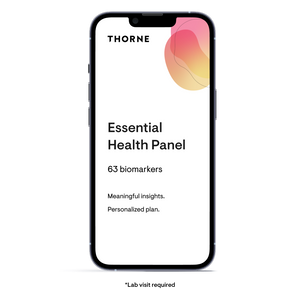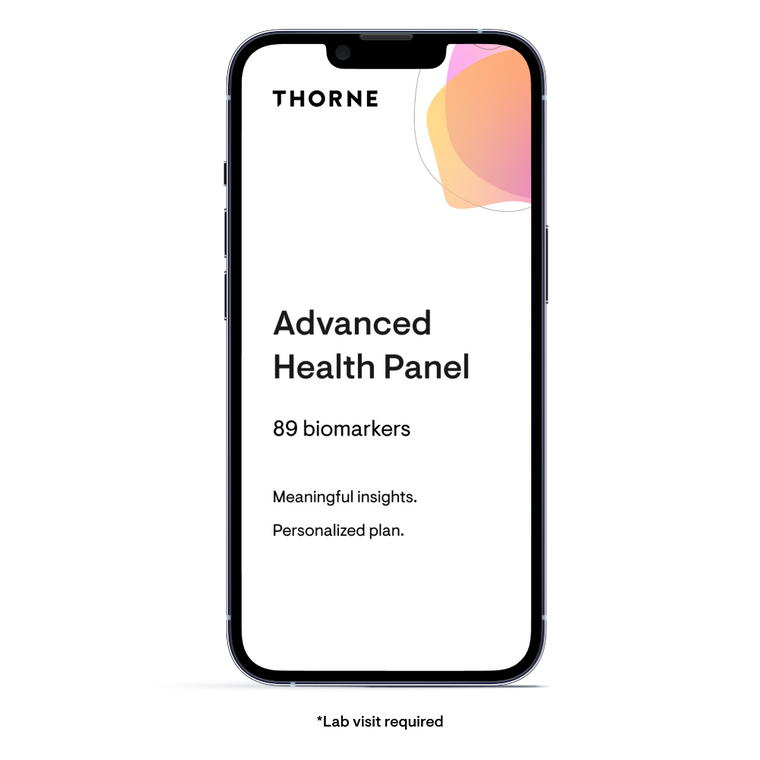
Advanced Health Panel 101
The Advanced Health Panel is Thorne's most comprehensive and all-inclusive health test available. This health test enables a person to optimize their unique biochemistry with meaningful insights and a personalized plan. This health test is recommended if you are: an athlete training for an event or simply wanting to improve performance, an individual trying to lose weight, , or a person taking control of your health and wellness. The biomarkers in this test contribute to many aspects of overall health and wellness.
No single biomarker acts alone in the body; similarly, each biomarker is responsible for multiple physiological processes and symptoms. The body's biology is complex and constantly changing, and therefore, blood values should be analyzed together to compare absolute amounts, ratios, percentages, and current health status to decide a plan of action to optimize health.
Thorne's Advanced Health Panel was designed by a group of medical doctors, researchers, naturopathic physicians, and dietitians to analyze the most clinically relevant biomarkers that support whole-body health and wellness. The biomarkers tested span the entire body but the results are presented in groupsfor easy reading and understanding. The test results provide easy-to-follow practical lifestyle, diet, and supplement options that support optimizing the biomarkers that are out of range and helping you reach your wellness goals. When a person's body is operating as it should, they will have more energy, a better mood, improved sleep, healthy immune function, normal brain function, and generally be more productive.
Why are These Biomarkers Important?
Muscle Performance
Whether a person is an athlete, a parent, or an aging adult, muscular health plays a role in strength, stamina, endurance, sleep, and risk for injury or illness. Musculoskeletalhealth is an important system to consider, even in younger years because bones and muscles are closely linked to health and wellness, and their density and composition generally decline with age A surprising number of blood biomarkers that play a role in bone and muscle function are included in this test:
- Vitamin D
- Total testosterone
- RBC magnesium
- SHBG
- Creatinine
- DHEA-S
- Albumin
- Total protein
Overall Health and Wellness
Immune function needs to working efficiently to resist the toxins and pathogens encountered daily. Similarly, red blood cells must perform daily to carry oxygen to every muscle, tissue, and organ in the body. Health and wellness relies on many biomarkers that, if out of range, might not produce symptoms that would alert you that something is amiss., So it is important to monitor these regularly:
- RBCs
- WBCs
- Eosinophils
- Monocytes
- Basophils
- Leukocytes
- Hemoglobin
- Hematocrit
Macronutrient Metabolism
Some biomarkers reflect how well you are metabolizing the food you eat. Lipid levels, blood sugar metabolism markers, protein status, and fatty acid levels are a direct reflection of your diet and metabolism and are assessed by these biomarkers:
- Lipids
- HbA1c
- Glucose
- Total protein
- Creatinine
- Fatty acid panel – Omega-3 Index, EPA, DHA, Omega-6:Omega-3 ratio
Injury Risk
Every athletic endeavor potentially puts the participant at risk for injury, like overuse injuries, aches, pains, and accidents. Athletes who participate in contact sports have the highest risks. But a person needn't be an athlete to want to reduce their risk of getting injured while going about their daily activities. Minimizing inflammation, optimizing hormone levels, supporting bone and muscle mass, and making sure the brain has the fatty acids it needs is a place to start.
- TSH
- HS-CRP
- Cortisol
- RBC magnesium
- Vitamin D
- DHA
- EPA
- WBCs
Risk for Chronic Disease
Age is a primary risk factor for multiple chronic diseases: dementia, heart disease, type 2 diabetes, arthritis, cancer, and more. Chronic disease is the leading driver of illness, disability, death, and health care costs. Learn early which biomarkers you can monitor and what you can do to modify them to decrease your risk of chronic disease.
A Deeper Dive into the Biomarkers:
- Cortisol – When it is elevated from mental, physical, or emotional stress, the primary stress hormone cortisol can break down muscle, raise blood sugar, cause excess fat storage, and suppress immune function.
- Cystatin C – Cystatin C is a protein produced by the body's cells. The kidneys work to keep this value at a normal level; therefore, it is indicative of kidney function. An elevated cystatin C corresponds to a decreased glomerular filtration rate and kidney dysfunction, as well as an increased risk for cardiovascular disease. Because it is a large molecule, blood levels of cystatin C might rise sooner than creatinine, allowing for a more sensitive detection and monitoring of kidney disease progression. Because this test is not necessarily affected by hydration status, it's a good marker for athletes, the elderly, and everyone in between to learn if the kidneys are working to detoxify the body.
- GGT – Gamma-glutamyl transferase (GGT) is an enzymatic indicator of liver disease. GGT is elevated in the blood in all forms of liver disease, including non-alcoholic fatty liver disease. It's estimated that more than 100 million U.S. adults (1 in 3) have some form of liver disease. Certain seizure medications and alcoholism (alcoholic cirrhosis) can also raise GGT levels. Learn if your liver needs attention and what to do to support it.
- Lipid Particle Sizes – Often LDL cholesterol and LDL particle number or size trend the same. If one is elevated, then the others likely are too – but not always. Lipid particles are a more detailed indicator of lipid health, and you will learn your risk for cardiovascular disease, metabolic syndrome, or diabetes.
- Fatty Acid Panel – A main component of red blood cell structure are fatty acids. Specifically, omega-3 fatty acids like EPA and DHA play an important role in maintaining red blood cell structure, so they can maintain their function of allowing certain nutrients, including water, in and out of the cell, supporting longevity of these cells so they can transport nutrients and oxygen throughout the body, and more. Research suggests the amount of omega-3's in the red blood cell membrane, known as the Omega-3 Index, has a strong association with brain functions like memory, processing speed, mood, and even risk for postpartum depression. Learn about your Omega-3 Index and other important fatty acid biomarkers.
- Homocysteine –The body naturally makes homocysteine, and vitamins B12, B6, and folate help break it down into other chemicals the body needs. However, because of a genetic variant in the MTHFR gene, affecting 1 in 3 people, the body is unable to efficiently reduce homocysteine and it builds up in the blood. At elevated levels, homocysteine can damage the lining of the arteries and increase the risk for blood clots. It also increases the risk for other health issues, including dementia, kidney disease, thyroid issues, osteoporosis, psoriasis, heart disease, and stroke. A high level can be related to a vitamin deficiency, alcohol intake, certain medications, or issues with the kidneys or thyroid. Learn if your homocysteine value is elevated and how to manage it.
- RBC Magnesium – Muscles, bone, and other tissues store 99 percent of the body's magnesium, with the other one percent in the serum and red blood cells. When serum magnesium does decrease, like with excessive sweating or increased energy production demands, magnesium is then pulled from tissue storage to maintain the tightly regulated blood magnesium level. This can mean that many effects of low-magnesium such as poor sleep, twitches, muscle weakness, cramps, fatigue, numbness, abnormal heart rhythms, or even seizures might be masked in common blood tests. Therefore, an RBC magnesium blood test provides a better indication of magnesium status than does serum magnesium (the more commonly measured biomarker).
- HbA1c – Otherwise known as hemoglobin A1c or glycosylated hemoglobin, this biomarker provides a running 90-day average of blood glucose level as measured by the percentage of the red blood cells that are saturated with sugar. Frequent carbohydrate consumption from meals or snacks, the under-production of insulin, or a sedentary lifestyle can significantly increase this value, which increases a person's risk for diabetes and insulin resistance.
The Science
Davidson MH, Ballantyne CM, Jacobson TA, et al. Clinical utility of inflammatory markers and advanced lipoprotein testing: advice from an expert panel of lipid specialists. J Clin Lipidol 2011;5(5):338-367.
Promoting Health for Older Adults. Published January 28, 2022. [Accessed May 10, 2022.] https://www.cdc.gov/chronicdisease/resources/publications/factsheets/promoting-health-for-older-adults.htm
CDC. MTHFR Gene, Folic Acid, and Preventing Neural Tube Defects. Centers for Disease Control and Prevention. Published July 7, 2020. [Accessed May 10, 2022.] https://www.cdc.gov/ncbddd/folicacid/mthfr-gene-and-folic-acid.html
Liver Disease Statistics. American Liver Foundation. Published October 26, 2017. [Accessed May 10, 2022.] https://liverfoundation.org/liver-disease-statistics/
- Affiliate Link:
- https://s.thorne.com/xXwhp








